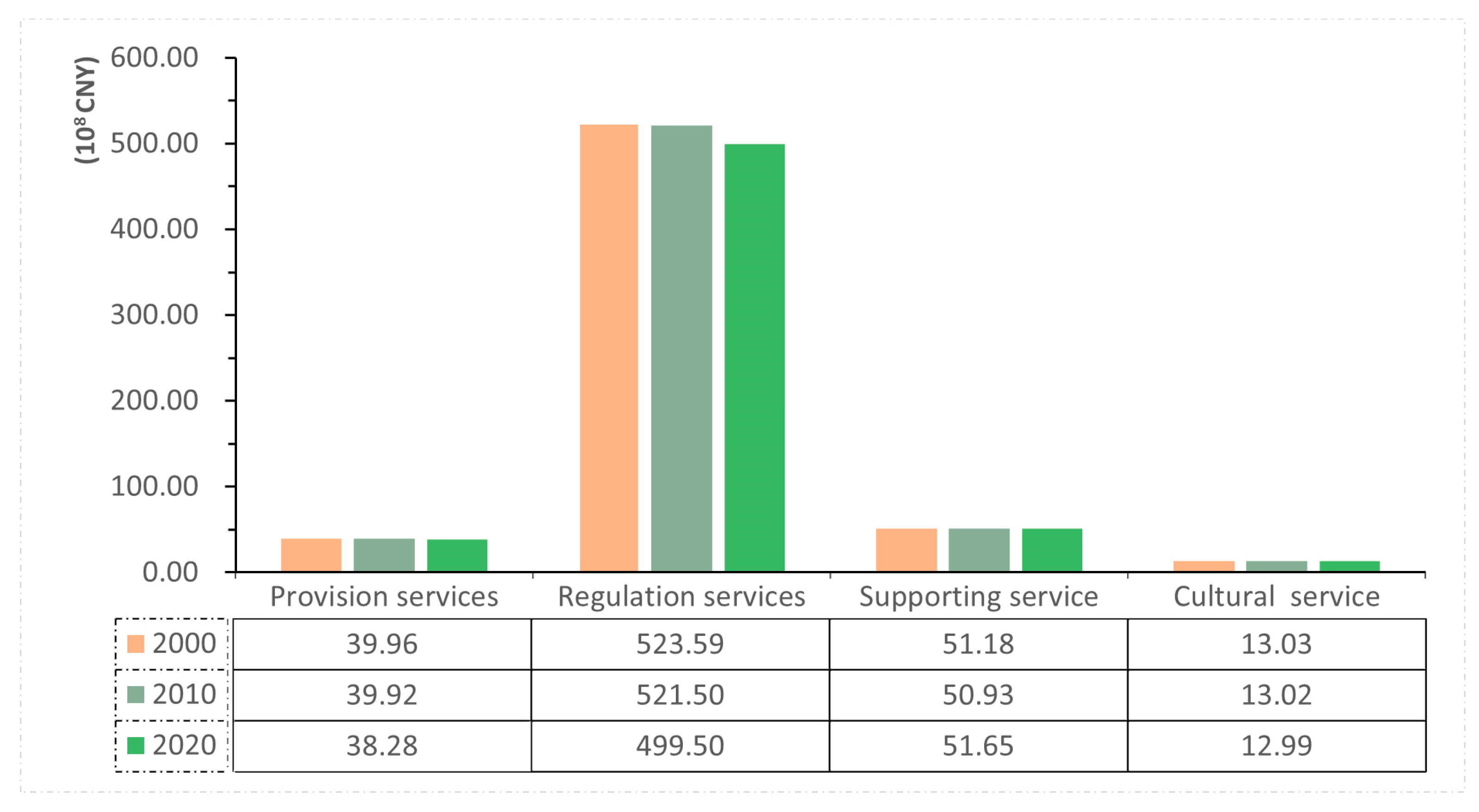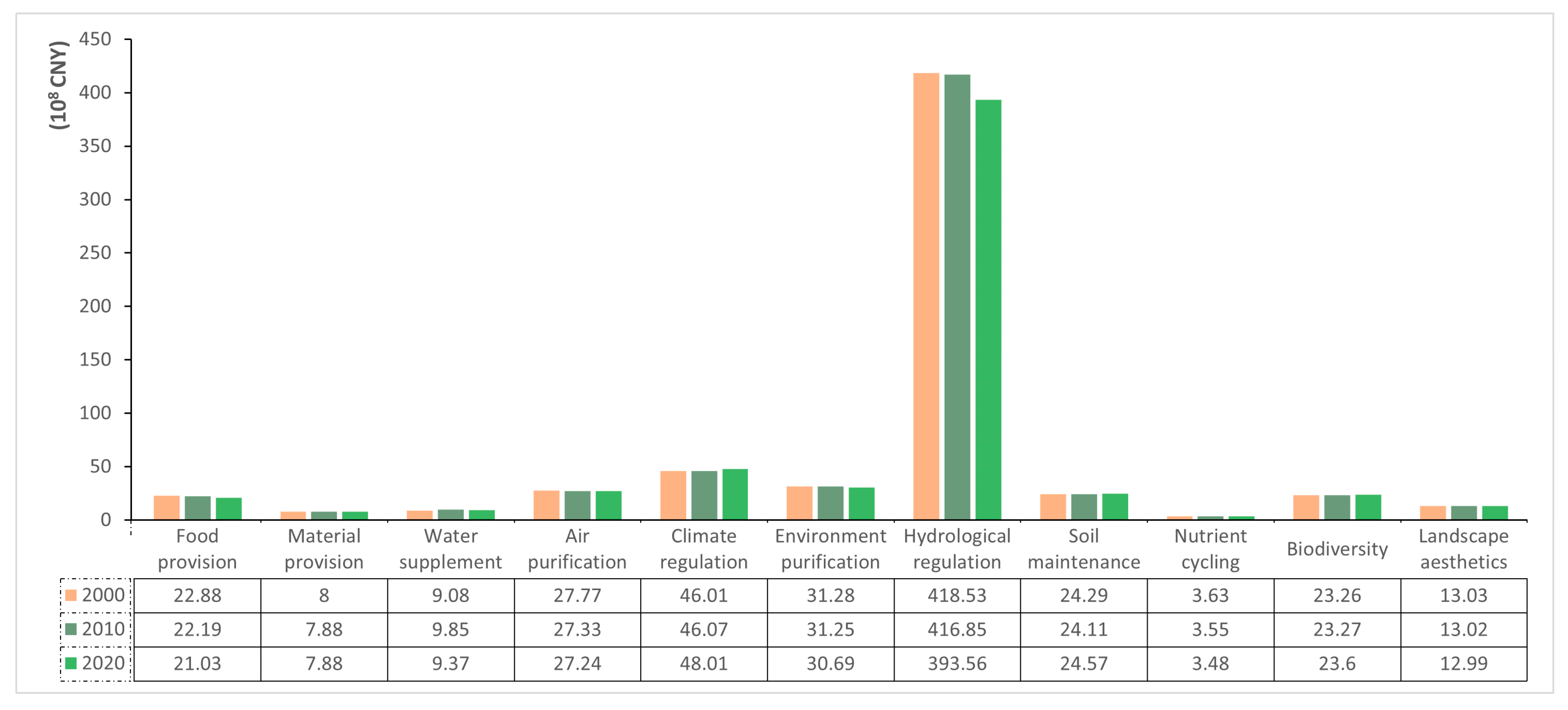1. Introduction
Ecosystem services (ES) refer to the essential processes through which ecosystems provide valuable benefits for human life and the Earth’s life-sustaining systems [
1]. The development of these services has consistently served as a critical indicator of the overall condition of the ecosystem [
2]. Amidst the ongoing urbanization trend, the reconfiguration of the environment has placed substantial pressure on ES, notably due to the detrimental impact of changes in land use on ecosystem integrity [
3,
4].
The connection between land use and the natural environment is intricate, representing a critical channel for the interplay between human activities and the natural world, and a pivotal element impacting the natural environment and ecosystems [
5]. With the acceleration of urbanization, the conflicts between human activities and land have continued to intensify. This has given rise to environmental contamination, such as land pollution [
6,
7], water source contamination [
8], and vegetation degradation [
9], further heightening these conflicts [
10]. Current research has shown that land use affects the spatial and temporal distribution of biological resources and interferes with fundamental ecological processes, such as material exchange and water cycling [
11], leading to habitat fragmentation [
12], the disruption of stable landscape ecological patterns, disturbing supply-demand relationships at the supply and demand levels of ecosystem services, and generation of resistance to ecosystem service flows [
13,
14]. The ecosystem services value (ESV) represents a measurable gauge of the capacity of ecosystem services, frequently employed to evaluate the well-being of ecosystem functions. First introduced by Costanza et al. [
15], subsequent scholars adopted the equivalence factor approach proposed by Xie et al. [
16], which has become a prevalent method for assessing the ESV. However, the factors influencing changes in ESV are evidently not adequately considered, underscoring the necessity for a comprehensive analysis and identification of the factors contributing to fluctuations in ESV.
The distinct advantage of Geodetector lies in its unique factor detection module and reliable statistical methodology for identifying key driving factors [
17]. Currently, many scholars are increasingly utilizing this method to uncover influential factors. For instance, Guo et al. [
18] employed Geodetector to scrutinize the key influencing factors behind desertification changes in the Yellow River source area. Similarly, in the study by Zhang et al. [
19], Geodetector was employed to analyze the determinants of the ecological quality of Chinese urban agglomerations, revealing that 73.68% of the ecological quality of the urban agglomerations was influenced by the expansion of the city’s built-up area and per capita GDP. Furthermore, Wang et al. [
20] used Geodetector to explore the factors shaping the spatial layout of the ecological network in Jinan City during the urbanization process, focusing specifically on the impact of changes in land use on the degradation of ecological network components.
Situated within the Wuhan urban agglomeration, the Liangzi Lake Basin (LLB) serves as a crucial ecological barrier in the Yangtze River region [
21], playing a vital role in water conservation and biodiversity protection. Acknowledged as a vital wetland in Asia, the LLB ensures regional ecological security. The 2022 14th Conference of the Parties (COP14) to the Convention on Wetlands in Wuhan underscored the global significance of wetlands in addressing climate change and biodiversity loss. However, rapid urban expansion, particularly in the Wuhan City Circle and surrounding satellite cities, has led to significant changes in land use and increased ecological risks. Human activities have posed a serious threat to the ecological stability of the LLB, leading to issues such as water eutrophication [
22,
23] and sediment pollution [
24], impacting the region’s ability to provide vital ecosystem services. Presently, most of the research related to the LLB is concentrated on aspects such as water environment, aquatic flora, and fauna habitats [
25,
26], with relatively limited attention given to ES. To address the research gaps in this area and considering its unique status and significant ecological value, the primary objective of this study is:
To analyze the evolving trends in land use patterns within the LLB between 2000 and 2020.
To quantify the repercussions of land use alterations on LLB’s ESV.
To elucidate the key drivers contributing to fluctuations in ESV within the LLB.
4. Discussion
The dominant land use categories in the LLB encompass arable land, forests, and water bodies. Over a period from 2000 to 2020, a significant decline has been observed in the area covered by both water bodies and arable land within the LLB. Simultaneously, the area allotted for construction has been progressively growing, and urban sprawl in the region might be the primary cause of this. To meet agricultural production demands, there has been a renewed intensification of farming activities around the lake [
46,
47,
48]. This initiative is poised to accelerate shifts in the region’s land utilization patterns, consequently leading to changes in ESV. These findings are consistent with the research conducted by other scholars in the field [
49,
50]. Between 2000 and 2020, the collective ESV within the study area witnessed a decline of 2.035 billion CNY. Some ecosystem services have experienced different degrees of decline, with the regulation service showing the most significant decrease. The main reason for the decrease can be traced to the reduced water area caused by lake reclamation and urban expansion [
51]. The growth of metropolitan areas in cities surrounding the LLB has led to a substantial reduction in arable lands, wetlands, and water bodies [
52]. Consequently, the decrease in the extent of these land use patterns was unquestionably linked to a decline in their corresponding ecosystem services.
The Yangtze River Economic Belt, encompassing the LLB, holds a significant position as an economic corridor in China. However, the concentration of cities inevitably triggers a rise in human activities, intensifying the strain on the ecosystem’s carrying capacity. In the examination of the primary influencing factors, the impact of human activities emerged as the foremost driver of ESV, notably evident in the interaction of two factors. This finding underscores the pivotal role of socio-economic development in elucidating the ESV changes, aligning with the various ecological challenges that have surfaced amid the region’s rapid growth [
53]. Hence, prioritizing ecological conservation alongside economic development is imperative. However, when it comes to different levels of administrative divisions and more complex geographical environments, the scope of factors of and the reliability of the data of GeoDetector can be limited for further research.
In terms of population, the number of residents in the study area has increased by about 510,000 between 2000 and 2020. The most significant surge in population, comprising roughly 370,000 individuals, was observed in Jiangxia District (Data source: see
Table S1). The growth of population echoed the changes in land use patterns; the surge in population led to urban expansion and intensive human activities [
54,
55]. These factors have amplified land utilization practices and brought about substantial modifications to the land use patterns of the LLB. As a result, extensive land and water areas have been encroached upon to facilitate urban development, resulting in serious environmental pollution and degradation in ecosystem services.
Unreasonable land utilization practices have resulted in the degradation of ecosystem functions. However, scientific and effective ecological policies can mitigate or offset the adverse consequences of rapid urbanization, as best exemplified by the ecological restoration project in the Three Gorges Reservoir area [
56]. Presently, the reduction in water surface area and arable land within the LLB continues to pose a significant hazard to ecosystem services. Consequently, cities surrounding the LLB must implement ecological conservation and restoration measures. For example, vigorously supporting the RFFP and similar projects reduce the intrusion of high-speed rails, expressways, and other transportation facilities into ecological spaces [
57,
58,
59]. Moreover, it is imperative for decision-makers and planners, when devising future planning policies and development projects, to exercise strict control over ecological conservation boundaries and arable land protection boundaries. This measure will help decelerate the trajectory of construction growth while enhancing the extent of water bodies and the prevalence of forests within the land utilization framework. Integrating ecosystem preservation into urban planning and lake basin development is pivotal to realizing the goal of aligning urban expansion with ecological preservation [
60].
5. Conclusions
Comprehensive research on ESV encompasses various fields, including ecology, geography, humanities, and social economics. This multidisciplinary approach adds to the uncertainty and complexity of the research. In this study, we delve deeply into the characteristics of changes in ecosystem service values within the region, primarily focusing on land use dynamics. Furthermore, we employ the GeoDetector methodology to meticulously scrutinize the driving forces influencing shifts in ecosystem service values within the basin and the interplay among these factors. This detailed analysis provides a precise quantitative assessment of the intrinsic factors responsible for the fluctuations in ecosystem service values. The study’s findings indicate that the intensity of human activities and the NDVI were the primary drivers of changes in ecosystem service values in the LLB during the study period. The rapid urbanization experienced has resulted in significant alterations to the region’s land-use structure, with substantial encroachments on lakes and arable land, consequently leading to a pronounced decrease in ecosystem service values. This study’s outcomes enhance our comprehension of ecosystem service values in the LLB, offering crucial theoretical support for forthcoming ecological restoration projects and economic development initiatives.
In order to more accurately depict the temporal variations in ecosystem service values, this study relied on statistical data from the years 2000, 2010, and 2020. Nevertheless, it is essential to recognize that ecosystem services operate as continuous, ongoing processes, and therefore, solely utilizing data from these three benchmark years may not comprehensively represent the overall changes that transpired over a 20-year period. In forthcoming research, the inclusion of data from additional years and diverse regions should be contemplated to heighten the precision of research outcomes. Furthermore, the integration of other theoretical models, such as the FLUS model [
61], could be explored to simulate the evolution of ESV under various scenarios and multifaceted influences, thereby affording a more accurate characterization and prediction of the spatiotemporal dynamics of ESV over extended timeframes.
Concerning the evaluation of ecosystem values, this study employed a method predicated on the national average value per unit area. This method assumes uniformity in ESV across the entire land surface, although in actuality, variations may exist. At the same time, further attention needs to be paid to differences in the quality of the water body itself in the assessment to improve the accuracy of the study [
62]. However, it is essential to emphasize that the primary focus of this study was to perform a driver analysis, and as a result, the impact of ESV heterogeneity on the research findings remained relatively limited. In future research endeavors, opportunities exist to further enhance and refine the accuracy of this particular aspect.













